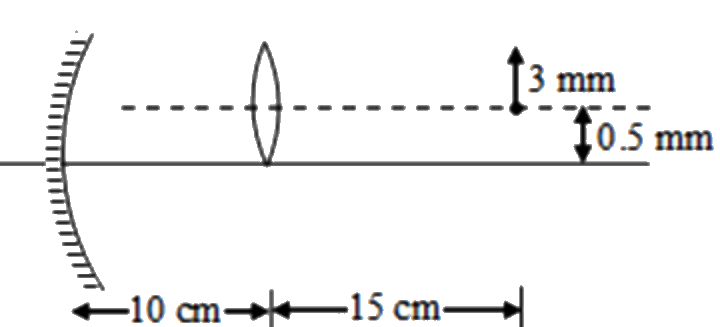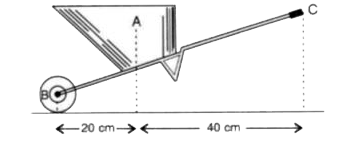A fire tongs has its arms 20 cm long. It is used to lift a coal of weight 1.5 kgf by applying an effort at a distance of 15 cm from the fulcrum. Find : (i) the mechanical advantage of the togns, and (ii) the effort needed.
The correct Answer is:(i) 0.75
(ii) 2.0 kgf.
To solve the problem step by step, we will break it down into two parts: finding the mechanical advantage and calculating the effort needed.
Step 1: Find the Mechanical Advantage (MA)
1. Identify the lengths of the arms:
- The length of the effort arm (distance from the fulcrum to where the effort is applied) is given as 15 cm.
- The length of the load arm (distance from the fulcrum to the load) is the total length of the tongs, which is 20 cm.
2. Use the formula for Mechanical Advantage:
Mechanical Advantage (MA)=Effort ArmLoad Arm
3. Substitute the values into the formula:
MA=15 cm20 cm=1520=34=0.75
Step 2: Calculate the Effort Needed
1. Use the relationship between Load, Effort, and Mechanical Advantage:
Mechanical Advantage (MA)=LoadEffort
2. Rearrange the formula to find Effort:
Effort=LoadMA
3. Substitute the values into the formula:
- The load (weight of the coal) is given as 1.5 kgf.
- We already calculated MA as 34.
4. Calculate the effort:
Effort=1.5 kgf34=1.5×43=63=2 kgf
Final Answers:
(i) The mechanical advantage of the tongs is 0.75 or 34.
(ii) The effort needed to lift the coal is 2 kgf.
---
- The length of the effort arm (distance from the fulcrum to where the effort is applied) is given as 15 cm.
- The length of the load arm (distance from the fulcrum to the load) is the total length of the tongs, which is 20 cm.
Mechanical Advantage (MA)=Effort ArmLoad Arm
MA=15 cm20 cm=1520=34=0.75
Mechanical Advantage (MA)=LoadEffort
Effort=LoadMA
- The load (weight of the coal) is given as 1.5 kgf.
- We already calculated MA as 34.
Effort=1.5 kgf34=1.5×43=63=2 kgf
(i) The mechanical advantage of the tongs is 0.75 or 34.
Topper's Solved these Questions
- BOOK - ICSECHAPTER - MACHINESEXERCISE - EXERCISE-3(B)20videos
MACHINES
- BOOK - ICSECHAPTER - MACHINESEXERCISE - EXERCISE-3(B) MULTIPLE CHOICE TYPE3videos
MACHINES
- BOOK - ICSECHAPTER - MACHINESEXERCISE - EXERCISE-3(A) MULTIPLE CHOICE TYPE5videos
MACHINES
- BOOK - ICSECHAPTER - HOUSEHOLD CIRCUITS EXERCISE - EXERCISE -9(B) (MULTIPLE CHOICE TYPE)2videos
HOUSEHOLD CIRCUITS
- BOOK - ICSECHAPTER - QUESTION PAPER 2022 TERM 1EXERCISE - MULTIPLE CHOICE QUESTIONS40videos
QUESTION PAPER 2022 TERM 1
Similar Questions
A crowbar is of 125 cm length. Its fulcrum is at a distance of 25 cm from the load. Find out the mechanical advantage.
View SolutionA pair of scissors is used to cut a piece of cloth by keeping it at a distance of 8.0 cm from its rivet and applying an effort of 10 kgf by fingers at a distance of 2.0 cm from the rivet.
(a) Find : (i) the mechanical advantage of the scissors, and (ii) the load offered by the cloth.
(b) How does the pair of scissors atc : as a force multiplier or as a speed multiplier ?View SolutionA crowbar of length 120 cm has its fulcrum situated at a distance of 20 cm from the load. Calculate the mechanical advantage of the crowbar.
View SolutionA cook uses a fire tongs of length 28 cm to lift a piece of burning coal of mass 250 g. if he applies effort at a distance of 7 cm from the fulcrum, find the effort. Take g=10ms−2.
View SolutionA class-three lever has a length of 150 cm and the effort is applied at a distance of 50 cm from the fulcrum. The MA is
View SolutionA parabola reflector is 15 cm deep and its focus is at a distance of 5 cm from its vertex. Find the diameter of the reflector.
View SolutionA man uses a crowbar of length 1.5m to raise a load of 75 kgf by putting a sharp edge below the bar at a distance of 1 m from his hand. (a) draw a diagram of the arrangement showing the fulcrum (F), load (L) and effort (E) with their direction. (b) state the kind of lever. (c) Calculate : (i) load arm, (ii) effort arm, (iii) mechanical advantage, and (iv) the effort needed.
View SolutionA bar magnet of length 1cm and cross-sectonal area 1.0cm2 produces a magnetic field of 1.5×10−4T at a point in end-on position at a distance 15cm away from the centre. (a) Find the magnetic moment M of the magnet. (b) Find the magnetization I of the magnet. (c) Find the magnetic field B at the centre of the magnet.
View SolutionA concave mirror of focal length 20 cm and a convex lens of focal length 10 cm are kept with their optic axes parallel but separated by 0.5 mm as shown in the figure. The distance between the the lens and mirror in 10 cm. An object of height 3 mm is placedon the optic axis of lens at a distnace between the lens and mirror is 10 cm. An object of height 3 mm is placed on the optic axis of lens at a distance 15 cm from the lens. Find the length of the image formed the mirror in mm.
 View Solution
View SolutionFigure below shows a wheel barrow of mass 15 kg carrying a load of 30 kgf with its centre of gravity at A. the points B and C are the centre of wheel and tip of the handle such that the horizontal distance AB=20 cm and AC=40 cm.

Find: (a) the load arm, (b) the effort arm,
(c) the mechanical advantage, and (d) the minimum effort required to keep the leg just off the ground.View Solution

